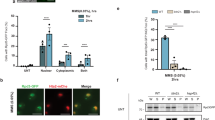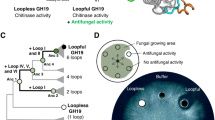Abstract
Deg1 is a chloroplastic protease involved in maintaining the photosynthetic machinery. Structural and biochemical analyses reveal that the inactive Deg1 monomer is transformed into the proteolytically active hexamer at acidic pH. The change in pH is sensed by His244, which upon protonation, repositions a specific helix to trigger oligomerization. This system ensures selective activation of Deg1 during daylight, when acidification of the thylakoid lumen occurs and photosynthetic proteins are damaged.
This is a preview of subscription content, access via your institution
Access options
Subscribe to this journal
Receive 12 print issues and online access
$189.00 per year
only $15.75 per issue
Buy this article
- Purchase on Springer Link
- Instant access to full article PDF
Prices may be subject to local taxes which are calculated during checkout



Similar content being viewed by others
Accession codes
References
Adir, N. et al. Photosynth. Res. 76, 343–370 (2003).
Aro, E.M. et al. Biochim. Biophys. Acta 1143, 113–134 (1993).
Barber, J. & Andersson, B. Trends Biochem. Sci. 17, 61–66 (1992).
Long, S.P. et al. Annu. Rev. Plant Physiol. Plant Mol. Biol. 45, 633–662 (1994).
Bailey, S. et al. J. Biol. Chem. 277, 2006–2011 (2002).
Kapri-Pardes, E. et al. Plant Cell 19, 1039–1047 (2007).
Lindahl, M. et al. Plant Cell 12, 419–431 (2000).
Sakamoto, W. et al. Genes Cells 7, 769–780 (2002).
Sun, X. et al. Plant Cell 19, 1347–1361 (2007).
Wilken, C. et al. Cell 117, 483–494 (2004).
Kirk, R. & Clausen, T. in Sensory Mechanisms in Bacteria: Molecular Aspects of Signal Recognition (eds. Spiro, S. & Dixon, R.) 231–254 (Caister Academic Press, 2010).
Hasselblatt, H. et al. Genes Dev. 21, 2659–2670 (2007).
Krojer, T. et al. Nat. Struct. Mol. Biol. 17, 844–852 (2010).
Clausen, T. et al. Mol. Cell 10, 443–455 (2002).
Krojer, T. et al. Nature 453, 885–890 (2008).
Dekker, J.P. & Boekema, E.J. Biochim. Biophys. Acta 1706, 12–39 (2005).
Chassin, Y. et al. Plant Physiol. 130, 857–864 (2002).
Lindahl, M. et al. J. Biol. Chem. 271, 29329–29334 (1996).
Ito, K. & Akiyama, Y. Annu. Rev. Microbiol. 59, 211–231 (2005).
Clausen, T., Kaiser, M., Huber, R. & Ehrmann, M. Nat. Rev. Mol. Cell Biol. 12, 152–162 (2011).
Acknowledgements
We thank R. Huber Max Planck Institute for Biochemistry and J.M. Peters Research Institute of Molecular Pathology for critical reading of the manuscript and helpful discussion, D. Charuvi (Hebrew University) for calculating the volume of the thylakoid lumen and C. Wilken Research Institute of Molecular Pathology for help with crystallizing Deg1. Crystallographic experiments were conducted at the beamline ID14-EH4 at the European Synchrotron Radiation Facility. This research was supported in part by a grant from the Israel Science Foundation to Z.A. The Research Institute of Molecular Pathology (IMP) is funded by Boehringer Ingelheim.
Author information
Authors and Affiliations
Contributions
J.K., B.S., B.B., R.K., R.R.K. and L.N. did the experiments and analyzed the data; P.C.S.-B., M.E. and Z.A. designed experiments and commented on the manuscript; and T.C. coordinated the project, designed experiments, analyzed the data and wrote the manuscript.
Corresponding authors
Ethics declarations
Competing interests
The authors declare no competing financial interests.
Supplementary information
Supplementary Text and Figures
Supplementary Figures 1–9, Supplementary Tables 1 and 2, and Supplementary Methods (PDF 1369 kb)
Rights and permissions
About this article
Cite this article
Kley, J., Schmidt, B., Boyanov, B. et al. Structural adaptation of the plant protease Deg1 to repair photosystem II during light exposure. Nat Struct Mol Biol 18, 728–731 (2011). https://doi.org/10.1038/nsmb.2055
Received:
Accepted:
Published:
Issue Date:
DOI: https://doi.org/10.1038/nsmb.2055
This article is cited by
-
The NtDEGP5 gene improves drought tolerance in tobacco (Nicotiana tabacum L.) by dampening plastid extracellular Ca2+ and flagellin signaling and thereby reducing ROS production
Plant Molecular Biology (2023)
-
Analysis of the changes of electron transfer and heterogeneity of photosystem II in Deg1-reduced Arabidopsis plants
Photosynthesis Research (2021)
-
FAM111A protects replication forks from protein obstacles via its trypsin-like domain
Nature Communications (2020)
-
Lumenal exposed regions of the D1 protein of PSII are long enough to be degraded by the chloroplast Deg1 protease
Scientific Reports (2018)
-
Structure function relations in PDZ-domain-containing proteins: Implications for protein networks in cellular signalling
Journal of Biosciences (2018)



